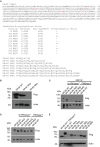SR-BI Interactome Analysis Reveals a Proviral Role for UGGT1 in Hepatitis C Virus Entry
- PMID: 31551978
- PMCID: PMC6743029
- DOI: 10.3389/fmicb.2019.02043
SR-BI Interactome Analysis Reveals a Proviral Role for UGGT1 in Hepatitis C Virus Entry
Abstract
Hepatitis C virus (HCV) entry is mediated by multiple co-receptors including scavenger receptor class B, type I (SR-BI). To elucidate the interactome of human SR-BI, we performed immunoprecipitation (IP) experiment coupled with mass spectrometry (MS) analysis. UDP-glucose:glycoprotein glucosyltransferase 1 (UGGT1), a key component of calnexin cycle involved in protein glycosylation, was identified as a SR-BI-interacting protein. Silencing UGGT1 or N-glycosylation inhibitor treatment reduced SR-BI protein level. Further study demonstrated that human SR-BI was N-glycosylated at nine asparagines. Moreover, HCV entry and infection were reduced by the absence of UGGT1. Interestingly, silencing SR-BI reduced protein stability of UGGT1 and protein quality control function mediated by UGGT1. Our finding not only identified UGGT1 as a HCV host factor, but also identified a UGGT1-mediated protein folding function for SR-BI.
Keywords: HCV; N-glycosylation; SR-BI; UGGT1; calnexin.
Figures







Similar articles
-
Scavenger receptor class B type I is a key host factor for hepatitis C virus infection required for an entry step closely linked to CD81.Hepatology. 2007 Dec;46(6):1722-31. doi: 10.1002/hep.21994. Hepatology. 2007. PMID: 18000990
-
The postbinding activity of scavenger receptor class B type I mediates initiation of hepatitis C virus infection and viral dissemination.Hepatology. 2013 Feb;57(2):492-504. doi: 10.1002/hep.26097. Epub 2012 Dec 28. Hepatology. 2013. PMID: 23081796
-
Human Herpesvirus 8 Interleukin-6 Interacts with Calnexin Cycle Components and Promotes Protein Folding.J Virol. 2017 Oct 27;91(22):e00965-17. doi: 10.1128/JVI.00965-17. Print 2017 Nov 15. J Virol. 2017. PMID: 28878084 Free PMC article.
-
Scavenger receptor class B type I and the hypervariable region-1 of hepatitis C virus in cell entry and neutralisation.Expert Rev Mol Med. 2011 Apr 14;13:e13. doi: 10.1017/S1462399411001785. Expert Rev Mol Med. 2011. PMID: 21489334 Review.
-
Hypervariable Region 1 in Envelope Protein 2 of Hepatitis C Virus: A Linchpin in Neutralizing Antibody Evasion and Viral Entry.Front Immunol. 2018 Sep 27;9:2146. doi: 10.3389/fimmu.2018.02146. eCollection 2018. Front Immunol. 2018. PMID: 30319614 Free PMC article. Review.
Cited by
-
A quinolin-8-ol sub-millimolar inhibitor of UGGT, the ER glycoprotein folding quality control checkpoint.iScience. 2023 Sep 20;26(10):107919. doi: 10.1016/j.isci.2023.107919. eCollection 2023 Oct 20. iScience. 2023. PMID: 37822503 Free PMC article.
-
Pan-cancer analysis of UGGT1 in human tumors and experimental validation in breast cancer.Sci Rep. 2025 Jul 24;15(1):26901. doi: 10.1038/s41598-025-12619-x. Sci Rep. 2025. PMID: 40707677 Free PMC article.
-
Self-Assembled Nanotubes Based on Chiral H8-BINOL Modified with 1,2,3-Triazole to Recognize Bi3+ Efficiently by ICT Mechanism.Micromachines (Basel). 2024 Jan 22;15(1):163. doi: 10.3390/mi15010163. Micromachines (Basel). 2024. PMID: 38276862 Free PMC article.
-
Viral and host heterogeneity and their effects on the viral life cycle.Nat Rev Microbiol. 2021 Apr;19(4):272-282. doi: 10.1038/s41579-020-00449-9. Epub 2020 Oct 6. Nat Rev Microbiol. 2021. PMID: 33024309 Free PMC article. Review.
-
Cellular factors involved in the hepatitis C virus life cycle.World J Gastroenterol. 2021 Jul 28;27(28):4555-4581. doi: 10.3748/wjg.v27.i28.4555. World J Gastroenterol. 2021. PMID: 34366623 Free PMC article. Review.
References
-
- Cao J., Chen Z., Ren Y., Luo Y., Cao M., Lu W., et al. (2011). Oral immunization with attenuated Salmonella carrying a co-expression plasmid encoding the core and E2 proteins of hepatitis C virus capable of inducing cellular immune responses and neutralizing antibodies in mice. Vaccine 29 3714–3723. 10.1016/j.vaccine.2011.02.083 - DOI - PubMed
LinkOut - more resources
Full Text Sources
Research Materials
Miscellaneous

